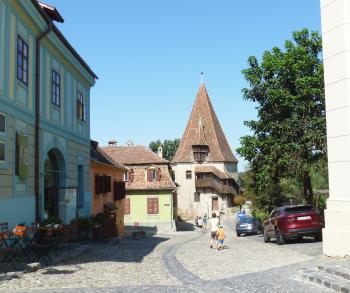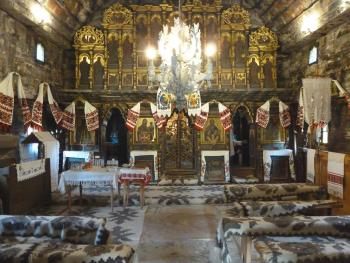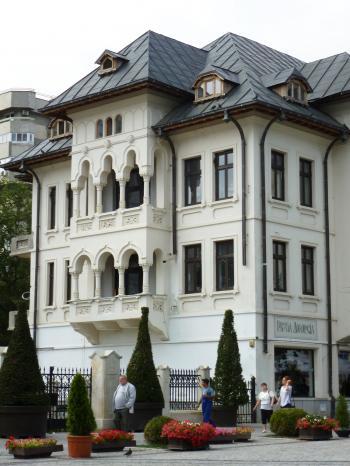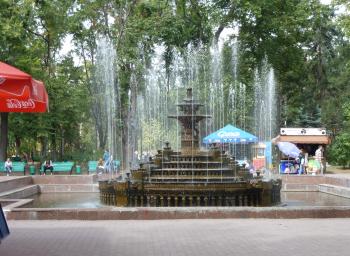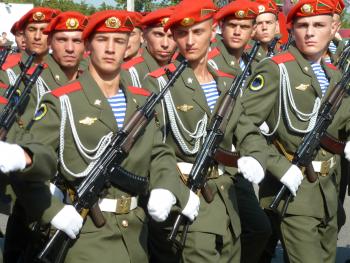Exploring the churches, cuisine and culture of Romania and Moldova, plus an eye-opening independence-day celebration
This article appears on page 6 of the February 2018 issue.
It was a leap of faith. ITN received a call from a subscriber who had just returned from a trip to Romania and wanted to let us know that he had enthusiastically encouraged the tour operator, Cultural Romtour, to contact our magazine in the hopes of introducing the company to the ITN “family” of travelers. The company’s owner, Razvan Balint, soon reached out with an offer to host a representative of ITN on a late-August 2017 tour. Since I was already going to be in Germany that summer visiting family — just a 2-hour flight away from Bucharest — I happily accepted.
My father was born and spent his youth in Romania before coming to the US at the age of 12, so I was interested in exploring the country that had shaped my family’s traditions. I had been to Romania once before but spent only three days there as part of a whirlwind, 3-country tour, and I didn’t get to see much beyond the major tourist sites in the southern half of the country.
I soon discovered that this was to be a private tour — just the company owner and me — and I agreed to leave the planning up to Razvan. In addition to their home office in Bucharest, Romania, the company has a sister office in Moldova, a country that would also be featured in my travel plan.
With brief correspondence via email, a rough outline of my trip began to emerge. On Aug. 25, my stay in Germany over, I boarded a Blue Air flight in Stuttgart with a not-quite-complete itinerary in hand and hoped for the best.
A rocky start
After landing in the early evening at the Henri Coanda˘ International Airport in Otopeni, just north of Bucharest, I followed the well-marked path to baggage claim and proceeded outside to meet my host. Easy peasy. But then a moment of panic washed over me, as there was no one there who seemed to be looking for me.
Razvan had indicated, in case we missed each other, that there was a bar just outside the baggage area where I could meet him, but what appeared there instead was a grocery store. Did I tell him the correct airport? (Bucharest has two.)
He had also given me his cell phone number, but I didn’t have an international cell, and there was no Wi-Fi signal to be able to send a WhatsApp message (a great option for messaging that I use when traveling in Europe). What now?
After about 20 minutes of waiting, I saw a man come through the doors with a sign. Obviously there to pick someone up (not me, though), he proceeded up the escalator. I followed him and discovered a huge crowd of people waiting upstairs outside the international arrival gate, with a bar off to the side! My flight from Germany had been directed to a different baggage-claim area, I assume because I had arrived from another EU country. A minute later, Razvan found me, and we were soon on the road.
Our first stop was Bran, about 150 kilometers (less than 100 miles) away, for an overnight stay. But I had arrived on the last weekend of summer break, and the freeway was clogged with locals headed out for one last trip to the cool air of the mountains.
So, instead of taking the more direct route to our destination, we embarked on a winding, back-road journey that kept us moving (most of the time at speeds that were too fast for the roads we were on) but took longer than expected, more than three hours!
Had I known then what I know now, I could have taken a short TAROM flight from Bucharest to Cluj, closer to the area to which we were headed, for less than $50.
On to Maramures
We were back on the road before breakfast, this time headed toward Maramures¸, near Romania’s northern border. After about an hour of zipping through villages and past fields and fields of sunflowers (beautiful!), we stopped for breakfast at a cute boutique hotel, where I had my first taste of zacusca˘, a spread of eggplant and roasted red peppers, which was delicious.
Then we were off again, stopping for a stroll through the pretty medieval town of Sighis¸oara before continuing on the 180-kilometer journey from there to our day’s final destination.
Just when I was beginning to get a little frustrated with so much time spent in the car, we unceremoniously turned off the main road, and I soon found myself standing in front of a truly impressive sight: the soaring Church of the Presentation of the Virgin Mary at the Temple in Bârsana, one of the eight wooden churches in Maramures¸ collectively designated as a UNESCO World Heritage Site.
Except for the woman who arrived (after a phone call) to let us in, we were the only people there, and I was allowed to explore this amazing church accompanied only by the sounds of the birds outside. The entire interior of this early-18th-century church was covered in beautiful frescoes — slightly faded but wonderfully preserved. Now, that was worth the bum-numbing car ride!
We ended the day at Pensiunea Doina, a lovely little guest house with an alpine feel. Dinner there was a treat, especially the ma˘ma˘liga˘ cu brânza˘ that Razvan called ahead to order. This polenta-and-cheese dish was a staple in my home growing up, and it brought back happy memories. (This version, with bits of homemade sausage mixed in, was especially yummy!)
Before the evening came to a close, Razvan asked me if I liked doughnuts. Images of my grandmother mixing a huge batch of dough by hand and the golden, round confections rolled in sparkling sugar that followed flooded my brain. Of course, I said, “Yes!” After a quick phone call, the next morning’s treat was set.
Over the mountain
Our morning drive on to Bucovina was an adventure, to say the least. After a stop to visit Razvan’s friend, the maker of the aforementioned doughnuts (served topped with fresh cream and cooked blueberries — incredible), we headed out over the mountain with the warning that they were “working on the roads.” Nothing could have prepared me (or Razvan… or his poor Ford sedan) for the hair-raising ride.
Apparently, fixing one portion of the road at a time — scraping it down and repaving it section by section — was not in the game plan for the construction crew. Instead, miles and miles of road had been scraped down, leaving rutted asphalt/gravel, often with half the road inches higher than the other and plunging drop-offs on one side as we drove up and over the mountain pass. (Hopefully, by now, the roads have been finished and the ride for those who follow will be a smooth one.)
However, at the end of our harrowing journey was a site I had long wanted to visit, one of the painted monasteries of Bucovina.
We arrived at Voronet¸ Monastery, near the town of Gura Humorului, just as the sun peeked out of the clouds to shine on the brightly colored frescoes that covered the exterior of the church. Built by Stephen the Great in 1488, this church is noted for the brilliant-blue background of its well-preserved paintings, which were added in the mid-1500s.
A UNESCO World Heritage Site, it was the first place where we encountered a number of tour groups, but Razvan, anticipating the timing of the tour groups’ movements, got us into the church before the large crowds arrived, which allowed for a rather peaceful experience.
But the excitement wasn’t over yet. That evening’s hotel, Pensiunea La Rota, was an attraction in itself. A collection of traditional homes had been relocated to a hillside in Gura Humorului, and all had been comfortably updated and authentically decorated to serve as individual cottage accommodations.
My 2-bedroom home for the night, Casa Zenovia, was awesome, and the friendly, English-speaking staff went out of their way to make sure their guests had everything they needed.
On to Moldova
My time in Romania was coming to an end, and the university city of Ias¸i would be our last stop before heading over the border into Moldova.
As we drove into the city, I took in the somewhat depressing Soviet-style buildings on the outskirts, which left me wholly unprepared for the lovely pedestrian street of Renaissance and Baroque buildings reminiscent of the grand architectural styles of Paris and Venice. Who knew?!
The next morning’s border crossing was relatively painless, and it was time for my first Moldovan experience: a cooking lesson.
Those who are familiar with my past travels know that I enjoy exploring the local cuisine, and the chance to have a hand in preparing it was something I was looking forward to.
In an open-air kitchen, my gracious host wrapped me in an apron and tied a babushka on my head (photos of which I’m sure my sister is planning to use in the future for some form of blackmail). She then guided me through a couple of traditional dishes: stuffed peppers, made in that area with veggies rather than the beef-and-rice mixture I was familiar with, and a savory pla˘cinta˘, thin pastry filled with soft, fresh cheese.
The dishes were relatively simple, but the interaction was fun, and the spread that was set out for lunch — an amazing array of dishes that included my handiwork — was wonderful.
The day’s end found us in Chis¸ina˘u, where Cultural Romtour’s Moldovan office is located. There I would be joined by a couple who had booked an introductory tour of Moldova, so while they traveled with Razvan, I would follow with his colleague, Nelu.
The next few days were filled with monastery visits, a walking tour of Chis¸ina˘u (led by our informative guide, Victoria), an evening of wine tasting and a drive-by tour of the garish Gypsy “castles” of Soroca and a visit with their “king,” who welcomed us into his home. We also took an interesting tour of the underground wine cellars of Cricova, featuring 120 kilometers of tunnels carved from the limestone upon which the city rests.
However, what I most remember from my visit there were the people I met. As Nelu said, the Moldovan people are “kind,” and I would have to agree.
The grand finale
My tour of Moldova was to come to a close with a grand celebration, the independence day parade of Transnistria, which is a self-declared republic that, well, isn’t really.
Comprising a small strip of land along the Dniester River, with Ukraine visible just on the other side, this region of Moldova screams “Soviet state,” from its unnecessarily complicated border-crossing rigamarole to its hammer-and-sickle-bearing flag and the statues of Lenin that dot the landscape (including a gilded one of him reading to children that sat on the lawn of a schoolhouse).
It was oddly comical but, at the same time, a little scary.
Come to think of it, I could use the same description for the well-attended parade, which began with troops in uniforms and polished boots goose-stepping in unison while senior officers whizzed by in jeeps yelling something in Russian.
This display, which went on for some time, was promptly followed by children and young adults dressed in traditional folk costume and small children in brightly colored outfits waving pom-poms. Then came people on bikes trailing oversized flags and riding in loops down the parade path. It all reached a crescendo as the streets filled with… ballroom dancers.
My time in Transnistria was a truly bizarre, once-in-a-lifetime experience.
The details
Cultural Romtour (Bucharest, Romania; www.culturalromtour.com) offers a number of scheduled tours of Romania and neighboring countries as well as private tours that can be customized to the interests of individual travelers.
Their 10-day cultural tour of Romania and Moldova (land only, €1,290, or $1,540, per person, double, with a €317 single supplement, based on a minimum group size of 10) includes many of the same sites that I visited. Special-interest tours are also offered, with themes such as wine, food or photography.
While my tour included a number of wonderful sites, what made it really special were the little surprises along the way. Razvan often stopped at the side of the road to buy fresh fruit for our journey or a pastry typical of the area, just so I could try it.
Seeing that I was especially interested in the painted monasteries and wooden churches, he gave me beautiful books with details on the ones we weren’t able to visit, and he found a cookbook for my father with recipes from Transylvania, the region in which he grew up.
Razvan brought gifts, as well, for the local guides, monks, vendors and friends we encountered along the way, and he was always warmly greeted with the recognition a good friend would be given.
It was evident that he cares deeply about his country and its people, and I came away feeling a little more connected to my heritage.

